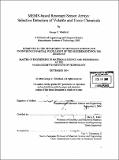| dc.contributor.advisor | Harry L. Tuller. | en_US |
| dc.contributor.author | Whitfield, George C. (George Calvin) | en_US |
| dc.contributor.other | Massachusetts Institute of Technology. Dept. of Materials Science and Engineering. | en_US |
| dc.date.accessioned | 2005-09-27T18:48:55Z | |
| dc.date.available | 2005-09-27T18:48:55Z | |
| dc.date.copyright | 2004 | en_US |
| dc.date.issued | 2004 | en_US |
| dc.identifier.uri | http://hdl.handle.net/1721.1/28874 | |
| dc.description | Thesis (M. Eng.)--Massachusetts Institute of Technology, Dept. of Materials Science and Engineering, 2004. | en_US |
| dc.description | Includes bibliographical references (leaves 58-59). | en_US |
| dc.description.abstract | With growing concerns about homeland security, public health, and environmental cleanliness, there is a strong need today for robust chemical sensing systems that are portable in addition to being highly sensitive. While there are many options available for gaseous chemical detection and identification, not all are well-suited toward the creation of a portable device. Boston MicroSystems, Inc. (BMS) has developed a resonant chemical sensor that is predicted to meet the performance needs of the current market in terms of gas sensitivity, operational reliability, and overall device portability. Desirable device characteristics are attained through integrating aluminum nitride and silicon carbide in processes that are protected through a strong base of intellectual property. By developing a standardized platform for gas detection based on this sensor technology, barriers to entering the targeted markets may be overcome. | en_US |
| dc.description.statementofresponsibility | by George C. Whitfield. | en_US |
| dc.format.extent | 59 leaves | en_US |
| dc.format.extent | 3738430 bytes | |
| dc.format.extent | 3743743 bytes | |
| dc.format.mimetype | application/pdf | |
| dc.format.mimetype | application/pdf | |
| dc.language.iso | en_US | |
| dc.publisher | Massachusetts Institute of Technology | en_US |
| dc.rights | M.I.T. theses are protected by copyright. They may be viewed from this source for any purpose, but reproduction or distribution in any format is prohibited without written permission. See provided URL for inquiries about permission. | en_US |
| dc.rights.uri | http://dspace.mit.edu/handle/1721.1/7582 | |
| dc.subject | Materials Science and Engineering. | en_US |
| dc.title | MEMS-based resonant sensor arrays : selective detection of volatile and toxic chemicals | en_US |
| dc.title.alternative | Microelectromechanical systems-based resonant sensor arrays : selective detection of volatile and toxic chemicals | en_US |
| dc.type | Thesis | en_US |
| dc.description.degree | M.Eng. | en_US |
| dc.contributor.department | Massachusetts Institute of Technology. Department of Materials Science and Engineering | |
| dc.identifier.oclc | 60425410 | en_US |
